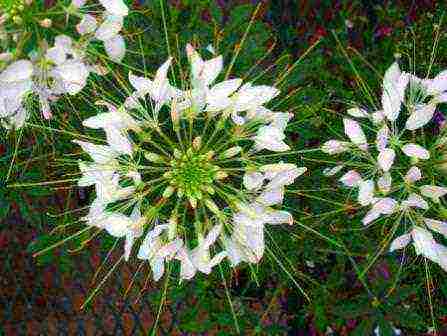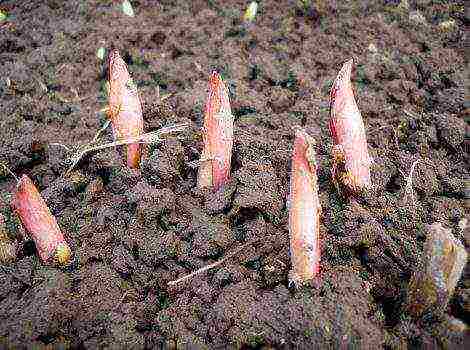Content [show]
The genus Phlox belongs to the Polemoniaceae family and has more than 65 species. These plants are native to North America. All representatives of the genus are perennials, with the exception of the Drummond phlox, which is an annual plant.
The name of these beautiful flowers in translation from Greek means "flame". So the plant was named by Karl Linnaeus because of the fiery red color of flowers in wild species.
General information
Phlox, depending on the species, can have both erect and ascending or creeping stems. Their height ranges from 10-20 to 120-150 centimeters. Sessile leaves are located opposite, sometimes in the upper part of the stem can be arranged in the next order. Leaves can be oval-lanceolate, ovate-elongated or lanceolate with a solid edge.
The flowers have a diameter of 2.5 to 4 centimeters and form paniculate or corymbose inflorescences. Flowers delight the eye with a variety of colors: white, scarlet, blue, pink, lilac, red, with an "eye" in the center, etc. Phlox fruits are oval capsules with numerous small seeds.
Perennial phlox grown in the garden are derived from wild species as well as their hybrids. The appearance of phlox, like their botanical features, is very diverse and varies even within species. To systematize them, scientists have to resort to the methods of genetics.
Phlox are ubiquitous. They are found in the harsh climate of Alaska and Canada, and in the southern regions, where winters never happen. They grow both in a dry desert climate and in a humid temperate climate.
The appearance of wild-growing phlox directly depends on the place of their growth. So, phlox, living on stony taluses and bare rocks at an altitude of more than 3500 meters above sea level, undersized plants that form turf trees and, blooming, are covered with a cap of bright flowers. Phlox grow both in humid forests (for example, splayed phlox) and in dry mountain forests (stolon-bearing phlox).
They can also be found near rivers, in lowlands on moist soils, as well as in dry steppes, on sandy soils. Phloxes also differ in their relation to lighting. There are species that prefer to grow in the shade, and there are those that prefer growing in the bright sun and, with a lack of lighting, cease to please with their flowering.
Phloxes have a varied appearance. Most of the representatives have erect herbaceous stems, forming compact bushes with bright and lush inflorescences at the tops. In these species, only rhizomes with buds and the lower part of the stems overwinter. Phlox, forming dense turf, have creeping, branched stems with a large number of evergreen leaves.
These species bloom most often in spring and look like a solid carpet of pink, white, lilac or crimson-pink flowers. There are also phlox-semi-shrubs with woody perennial stems creeping along the ground.
The phlox flower consists of 5 petals and has a tubular-funnel shape. The petals are bent at right angles to the tube and form a flat rim, which can have a star-shaped, wheel-shaped, deeply dissected, notched, saucer-shaped, and other shapes. Flowers come in a wide variety of colors - monochromatic, with "eyes", dots, strokes, shadows.
to the table of contents
Types and varieties of phlox
Depending on the morphological features, phloxes are divided into 3 groups:
- Shrub;
- Loose sod;
- Creeping.
Bush phlox forms are distinguished by 2 more subgroups. The first includes tall plants, strong erect stems of which can reach 180 centimeters in height. By autumn, the base of the stems becomes lignified. Phloxes of this subgroup bloom in summer and early autumn with a large number of fragrant flowers that form large panicle inflorescences.
Representatives of the subgroup are smooth phlox, panicled phlox and spotted phlox. The second group included low-growing plants with straight or ascending strongly branching stems, ranging in height from 45 to 60 centimeters.
Phloxes of this subgroup form loose bushes with spherical-umbellate or corymbose inflorescences on the tops of the stems. Some representatives may have a shortened panicle or a sparse brush inflorescence. These bush phloxes delight with their flowering in late spring and early summer.
Representatives of this subgroup are hairy phlox, caroline phlox, oval phlox, adorable phlox and others. A characteristic feature of all bush phloxes is the absence of grooves and cuts in the edge of the corolla petals.
Loose turf representatives of phlox have strongly branching creeping vegetative stems with multiple flowering shoots extending from them. They got the name due to the fact that their creeping stems form a loose turf.
These phlox bloom in late spring or early summer. The most common representatives of this group are stolon-bearing phlox and wide-spread phlox.
Creeping the phlox group is characterized by branching, creeping stems that sometimes rise at the ends and form sods and cushions of varying density. The leaves of such phlox are narrow and small, collected in bunches in nodes and are often evergreen.
Plants can be bare or pubescent. At the ends of the stems there are peduncles with one or more flowers. Creeping phlox bloom in spring. The most famous representatives are Hood's phlox, styloid phlox, Douglas phlox, snow phlox, dwarf phlox and star phlox.
During the period of introduction of phlox, a significant number of interspecific varieties and hybrids were bred, most of which form independent groups. For example, hybrids of Arends phlox were obtained as a result of crossing paniculata phlox with splay phlox. The first hybrid from such a cross was obtained in 1910 by the breeder J. Arends (hence the name phlox).
Over the next few years, 13 more varieties were obtained, almost all of which, unfortunately, have now been lost. The modern collection of Arends phlox hybrids consists of several varieties that combine the duration of the flowering of the paniculata phlox with the early flowering of the splay phlox.
to the table of contents
Phlox planting and care in the open field
Phloxes are unpretentious plants, but in order to achieve abundant and long-lasting flowering, you must choose the right place for their planting. It is best to plant the plants in a place protected from the wind.
Phlox can grow both in partial shade and in the sun. At the same time, in sunny places, the flowering of phlox is not long, and the flowers of some varieties may even fade and fade under the influence of sunlight.
Plants prefer soil that is loose, fertile, with a neutral or slightly acidic reaction and sufficient moisture, but without stagnant water. It is advisable to prepare the soil in the fall before the spring planting of flowers.
To do this, it is processed to a depth of 30 centimeters (there is no need for deeper, since the root system of phlox is in the upper ball of the soil) and wood ash, compost and superphosphate are added.
If the soil is clay, then it is necessary to add sand to it, in the amount of 1 bucket per square meter, and organic fertilizers. If the reaction of the soil is acidic, then lime is added.
Plant care consists in periodic feeding, loosening the soil and watering in the absence of rain. For the winter, the stems of the plant should be cut off near the ground.
to the table of contents
Reproduction of phlox by dividing the bush
This is probably the most popular of the methods. The time for such a transplant is either early spring or after flowering in the fall to allow the seedlings to take root before winter. In the summer, such a transplant is also possible, but it should be done in the evening and with good watering. But it must be borne in mind that the separated seedlings must be large and it is imperative to save an earthen lump at the root. Provide regular watering after transplanting.
In the autumn period, we begin the division of the bush, with digging, it should be noted that this method of reproduction must be performed if the plant has already reached six years of age. Next, we completely remove the earth from the root system. After that, we carefully divide the roots that go to the stem. If the bush does not lend itself to separation by hand, use a knife. Having divided the roots, we check that each one has shoots' processes. The separated parts are immediately planted in the ground.
to the table of contents
Reproduction of phlox by cuttings
This breeding option involves three ways:
Reproduction of phlox stem cuttings, this method is not difficult and the best time for this is the period of active growth of the stems, before flowering, late May, early June. Choose good, healthy cuttings from an adult plant.
We divide the shoot so that there are several nodes on each cuttings. The leaves are those that are at the bottom of the cutting must be cut off completely, and the upper ones by half. We plant the cuttings in a container with loose nutrient soil and sprinkle a few centimeters of sand on top with a layer of sand.
If the planting is done in open ground, then sprinkle with leaves or peat about 8 centimeters and a layer of sand on top of a few centimeters. We moisten the soil and plant the cuttings on the upper knot with leaves, pressing the soil against them. We plant at a distance of about five centimeters from each other.
After planting, we place a container with cuttings in a greenhouse and hide from direct sunlight for a period of up to 21 days with watering up to 3 times a day. After the cuttings are accepted and rooted, green leaves begin to appear on them, it is necessary to transplant to a more spacious place at a distance of up to 16 cm.This method can be propagated throughout the season.
The second way, the reproduction of phlox leafy cuttings... This method is best applied at the beginning of July. Only with a blade you need to cut off a leaf with a bud and grab a little of the stem.
We plant the cutting in a container with loose soil and add a layer of one centimeter of sand. The distance between the plants is about five centimeters, we plant it deeply, taking into account that the bud and stalk are in the ground.
After disembarking, we cover the container with glass and leave it in a semi-dark place with a temperature regime of about 19 degrees. And we regularly moisturize, periodically airing, so that the cuttings do not overpower. After rooting, we plant it in the ground.
The third way, the reproduction of phlox, root cuttings... This method is laborious, but it is sometimes used to get rid of stem nematode parasites. Can be planted in spring and after flowering. Having dug up the plant, select the strongest roots and cut into 6 cm pieces.
We plant in a container with earth and sprinkle with a layer of sand about 5 cm. Water abundantly and wait for new shoots. If in winter, we put it in a cool basement and water it, not letting the soil dry out, and in the spring we take it out and accustom it to heat and light gradually, rooted cuttings with shoots are planted in open ground in May.
to the table of contents
Reproduction by layering
A simple method available to anyone, even a novice amateur gardener. Sprinkle the bushes with earth, the higher the better. And after some period, roots appear on the shoots. And when the roots take root, you need to cut them off and plant them in the ground.
to the table of contents
Seed propagation
Subulate phlox reproduce by seeds, but often with such reproduction varietal traits do not always remain.
Before sowing, in order to improve the seedlings, you need to clear them from the boxes. Because of its fragility, it is better to sow immediately after harvest. You need to choose the largest seeds and in November sow in open ground or a box.
In winter, the seeds will undergo natural selection and the most hardened ones will delight you with good shoots. They appear in May, when several leaves appear, they must be planted at a distance of about 15 cm from each other. Following all the rules of planting and care, you will actively develop and bloom.
to the table of contents
Phlox pests and diseases
Phloxes can be affected by pests and fungal, viral and mycoplasma diseases. Most often, plants are affected by powdery mildew. This is due to improper care or growing in the shade.
Phloxes often suffer from rust, verticillium wilting, white spot and mosaic.
The most dangerous of the pests is the stem phlox nematode. When a plant is damaged by this microscopic worm, the tops of the stems turn pale and twist, and the leaves become thinner.
The plant cannot be cured and must be dug up along with a large clod of earth and removed from the site so that other plants do not become infected.
to the table of contents
Use in landscape design
Phlox are excellent perennials for decorating flower gardens. Their popularity among gardeners is explained by frost resistance, unpretentiousness, ease of care, as well as the splendor and brightness of flowering.
Phloxes can be used as representatives of cottage gardens, village front gardens, in rock gardens near water bodies, landscape, romantic or avant-garde flower beds.
By choosing the right varieties of phlox, you can achieve flowering flower beds, starting in spring and ending in autumn. So creeping and loose-sourced phloxes will decorate the garden in spring and early summer, and spray ones - during summer and early autumn.
When planting plants, it is necessary to take into account their height and color of flowers so that the created compositions look harmonious.
You can also use fragrant phlox flowers to create bouquets. In this case, it is best to cut them off in the morning, having done the evening watering of the plant before that.
To ensure the formation of lush and dense inflorescences, it is recommended to leave no more than 7-8 stems in the bush.
to the table of contents
Phlox are incredibly beautiful bright flowers that have a strong pleasant aroma. Plants are perennial, therefore, for abundant flowering, you need to take care of favorable growing conditions. In the article, we will tell you about the cultivation of perennial phlox from seeds, we will give recommendations for planting and care.
How to propagate perennial phloxes in the garden
Unlike annual phlox, which are propagated only by seed, perennials are propagated in three ways:
- Seeds. Phlox is sown in spring, autumn or early winter.
- By dividing the rhizome. In the spring, the bush is dug up, the rhizome is divided into several parts and young bushes are planted. Most often, this vegetative method is used to rejuvenate a flower when it grows in one place for a long time.
- Cuttings. In early summer, cuttings are prepared, strong young shoots are chosen. They are planted in open ground under a jar, watered abundantly and await rooting. When sowing podzimnym phlox bloom next year in the fall.
If the bush has lost its decorative effect, then it is propagated by dividing the bush even in autumn (late August-mid-September). To update the phlox, the oldest rhizomes are thrown away, and only the side parts are planted.
Summer and spring reproduction is more successful than winter.
How to plant phlox seeds
There are two ways to grow a flower from seed.
Sowing seeds directly to the flower garden
Seeds are sown at the end of May or in November-December:
- Winter sowing. If snow has already fallen during winter sowing, then it is removed, the seeds are sown over the frozen soil at a distance of 5 cm from each other, sprinkled with earth with a layer of 2 cm and covered with snow. The germination rate when sowing in winter is 70%. Springs appear in the spring, and when two leaves bloom, the seedlings are planted at a distance of 20 cm from each other.
- Sowing in the spring. Phlox seeds are sown in fertilized moist soil. 4 seeds are placed in the hole. They are covered with earth, watered and covered with a film until shoots appear. Two weeks after the seeds come off, the flowers are already fed with slurry or nitrophos.
Sowing phlox seeds for seedlings
For seedlings, seeds are sown in boxes or peat tablets. The seeds are not buried deep in the ground, but placed on the surface. Cover with a film on top. The optimum temperature for seed germination is + 10-18 ˚С. Moisten the soil with a spray bottle.Stronger seedlings can be grown in peat tablets on the windowsill. With a high content of peat in the soil, the decorative effect of phlox increases.Read also the article: → "Features of growing annual phlox in the garden."
Favorable conditions for growing phlox
The main requirements are put forward to the quality of the soil. The decorativeness and development of phlox depend on the fertility of the soil. Soil requirements in the table.
| Characteristic | Description |
| Acidity | pH = 5.5-7.0 |
| Soil structure | Loose, fertile soil with a high humus content, medium moist |
| Unsuitable soils | Heavy clayey, swampy, light sandy loam, poorly drained soils |
The acidity of the soil is determined using a litmus test. Phlox suits the climate of the middle zone, where it is not very hot and moderate rainfall. For landing, choose an area with a flat relief, protected from the wind. Phlox is not planted in open sunny places, but shaded areas, where the flower is shaded from 11 to 14 o'clock, are ideal.
When growing seedlings, the following conditions are favorable:
- humidity above 70%;
- the temperature after the descent of seeds is up to 21 ˚С, within two weeks the temperature is lowered to 15 С;
- a container with seedlings is placed on sunny windowsills, and the film is removed.
Preparing the soil for planting phlox
If the soil is not suitable for planting phlox, it is improved:
- sand and manure are applied to clay soils;
- clay and lime are added to sandy loam, peat is also added to sandy ones;
- poor soils are filled with peat, manure or compost.
Prepare the soil in the fall. Contribute up to 8 kg / m. sq. peat or manure, up to 300 g / m are added to acidic lands. sq. lime. The soil is plowed to a depth of 30 cm. In the spring, the soil is plowed again, harrowed, and nitrophosphate and potassium salt are added. A week before sowing seeds, the soil is disinfected with a solution of potassium permanganate.
Phlox planting and care plan
Phlox seeds are sown in spring, summer, autumn or winter.It all depends on the growing method. Consider an action plan for growing and caring for seedlings.
| Action | Timing |
| Sowing seeds in pots | February |
| Picking | When 2-3 true leaves appear |
| Hardening (seedlings are taken outside for a day) | April-early May |
| Transplanting seedlings into open ground | May June |
| Pinching over the fifth pair of leaves | July |
| They are fed 5 times: | May-September |
| 1. Liquid manure (for 10 liters of water 100 g of manure). | The end of May |
| 2. Slurry with potassium salt or superphosphate. | The beginning of June |
| 3. Slurry or chicken manure solution. | Early July |
| 4. Superphosphate and potassium salt. | Early august |
| 5. Use ash, nitrophosphate, | Beginning of September |
| Pruning phlox and mulching the soil with peat | October November |
Phlox bloom from July to late September, prefer potash-phosphorus fertilizers
How to care for phlox in the garden
While phlox sprouts have not yet grown stronger after transplanting into open ground, the soil is regularly loosened, and the flowers are watered. Freshly planted phloxes are watered every three days for two weeks. The aisles are mulched with cut grass so that weeds do not germinate and moisture does not leave the soil.
If the summer is dry, up to 2 liters of water is poured under each bush every 2-3 days. In hot weather, the soil is mulched with peat or humus with a layer of 4 cm.
Tip # 1. In order for phlox to bloom profusely, faded inflorescences are always removed.
For abundant flowering, perennials are fed up to 5 times per season. Fertilizers for phlox are given in the table.
| Fertilizer name | Description | Application |
| "Ekorost" for garden flowers | Fertilizer based on humic acids. Increases seed germination, seedling survival, increases disease resistance. | Root and foliar feeding: 2 caps per 10 liters of water, watered every two weeks. |
| "Grow" fertilizer for flowers | A complex product that contains nitrogen, phosphorus and potassium. Accelerates growth, increases flowering duration and vividness of flowers | 1 tbsp. l. for 1 sq. m. |
| "Windsor" for garden and indoor | Comprehensive product that provides abundant and long-lasting flowering | 50-80 g / m2. sq., water the flowers 1-3 times for the entire growing season |
| "Bud-2" for garden flowers | Provides long-lasting and abundant flowering | 10-20 g / 10 l of water |
| Buysk Fertilizers "Flower Paradise" for flowering plants | A complex liquid that stimulates growth, blooms and increases disease resistance | 10 ml / 1 l of water |
| Universal fertilizer for garden flowers "Pokon" | Improves soil composition, nourishes flowers and accelerates their growth | 1 measuring spoon per 1 sq. M. They are fed once a season in the spring. |
Every 3-4 years in May, the bush is dug up and the rhizomes are divided... When grown in southern regions, the division of the bush can be postponed until September, the main thing is that the plant has time to take root before winter. Read also the article: → "Planting and caring for phlox in the spring."
In the fall, grown phloxes of spring sowing are planted
Regardless of the region of cultivation, perennial flowers are covered with peat or straw for the winter. In the South, fallen leaves are used instead of peat, but pests can grow in such mulch. Cover the bush when the stems turn yellow and dry. The dry tops are cut off, and the root zone is covered with a layer of mulch. In a snowy winter, if the layer of snowfall is more than 50 cm, phlox need not be covered. Flowers are afraid of snowless winters, even if the frost is -10-15 ˚С.
Tip # 2. Phlox is used in landscape design to create abundantly flowering flower beds. Flowers go well with monards, astilbe, marigolds and heliopsis.
With abundant watering in dry summers, flowers are affected by powdery mildew or septoria. For the prevention of diseases, flowers are treated with fungicides.
How to deal with pests and diseases of phlox
Among phlox diseases, spotting and powdery mildew are distinguished. Diseases are recognized by their characteristic features. Consider the symptoms of diseases and methods of dealing with them in the table.
| Name of the disease | Signs | Prevention and control methods |
| Spotting | Dots on the leaves, with their further twisting | Sick leaves are removed, and the flower itself is treated with Bordeaux mixture |
| Powdery mildew | White bloom on leaves and stems | To prevent contamination of healthy flowers, the diseased plant is removed and burned. |
| Variegated | Peculiar patterns appear on the leaves | |
| Fomoz | The leaves begin to dry out and the stems become thinner. | For prophylaxis in the spring, while the air temperature does not exceed 18 ° C, colloidal sulfur is sprayed on the stems and leaves |
| Septoria | Dark brown dots on the leaves | The bush and soil around is treated with Bordeaux liquid every two weeks |
For the prevention of diseases, the treatment of phlox with a solution of Bordeaux mixture should be included in the calendar of spring work in the garden. Pests include filamentous worms, nematodes, slugs and caterpillars. When the bushes are affected by nematodes or worms, the flower is dug up and burned. The land is treated with nematicides or lime every 20 days. Three treatments are needed.
Phloxes that grow on acidic soils are less sick
For the prevention of pests, insecticides are used. In the spring they are sprayed with Fury, Karate or Kinmix preparations. Read also the article: → "A brief overview of preparations for the treatment of the garden with instructions for use."
Features of growing perennials and annuals
Growing perennials is generally similar to breeding annual phlox, but there are the following differences:
- Perennials are more often sown in open ground, rather than growing seedlings.
- Perennials bloom later, but bloom longer.
- Before winter, perennials, unlike annual plants, are not sown, since they are not resistant to frost.
- Perennials need five feedings per season, and not 3-4, as is the case with annual phlox.
- Seedlings are not planted closer than 0.5 m from each other, because perennials grow strongly in one place.
Answers to common questions
Question number 1... When is the best time to sow seeds in a flower garden?
Phloxes belong to those garden flowers that reproduce year-round. They are planted in spring, summer and winter. But for seed reproduction, spring is more suitable. In the second half of April, phlox seedlings are planted in flower beds. Spring planting has its advantages. The flowers have time to take root, but they bloom two weeks later than planned.
Autumn planting with seeds is possible only in the southern regions and the middle lane, where frosts come later. Seeds are sown in early September. Before the first frost, the flowers take root, and bloom the next year in July.
Question number 2... How to dive phlox seedlings?
The sprouts dive 20 cm apart into a greenhouse or greenhouse. Also, each sprout is planted in a separate pot, and when it warms up, they are planted in open ground.
Question number 3... Is it possible to mulch the soil in summer in extreme heat?
Yes. To protect from the scorching sun, the soil is mulched with peat or humus with a layer of 5 cm. Watering can be done over the mulch.
Question number 4... When can you transplant phlox bushes?
The best period is April or September. Transplanted as needed in the summer, but without dividing the root system. Be sure to move the roots to a new hole along with an earthen lump.
Question number 5... What are the popular perennial varieties?
Popular varieties include the following perennials:
- Subulate. The plant is completely covered with white to dark red flowers. Blooms in May.
- Spread out. Blooms lilac-blue. The plant prefers shaded areas. Blooms in May.
- Paniculate. Blooms in the middle of summer. Inflorescences and leaves are large. Bushes 70-100 cm high.
Gardeners' mistakes when growing perennials
Gardeners' mistakes are as follows:
- In the heat, phlox should not be watered with cold water, otherwise the stems will crack.
- Withered flowers should not be left on the plant, they interfere with new blooming and delay flowering.
- Many gardeners do not cover phlox for the winter.If there is little snow in winter, then the flowers can die even at -10 ˚С, so it is imperative to mulch the soil in November.
- Phloxes cannot be planted in the area where strawberries were previously grown. Otherwise, the invasion of pests cannot be avoided.
Rate the quality of the article. We want to be better for you:
 Decorative bright phlox gardeners willingly grow on their plots because of the varied palette of colors and the long flowering from spring to autumn frosts. In addition, lush inflorescences can be cut off and made from them bouquets or compositions that will last for a long time. How to grow phlox from seeds, you can learn about the features of their planting and care from our article.
Decorative bright phlox gardeners willingly grow on their plots because of the varied palette of colors and the long flowering from spring to autumn frosts. In addition, lush inflorescences can be cut off and made from them bouquets or compositions that will last for a long time. How to grow phlox from seeds, you can learn about the features of their planting and care from our article.
Description of the plant
The first wild species flowers had a bright red color, for which they got their name - "phlox", which means "flame". Today the culture is spread all over the world and is very popular due to its unpretentiousness.
Most phloxes are perennials that differ in:
- compact bushy form;

- densely leafy creeping or straight stems from 10 to 150 cm high;
- a powerful root system that can easily withstand lush large bushes;
- oval-elongated, oppositely located sessile leaves;
- complex inflorescences located at the tops of the shoots, which consist of many small flowers, reaching 3–4 cm in diameter;
- flower corollas, which can be dissected, star-shaped, saucer-shaped or other shape;
- numerous colors of buds, which can be both pale white and purple, red or even variegated.
Beautiful and spectacular phlox grow quickly and are winter hardy.
Types and varieties
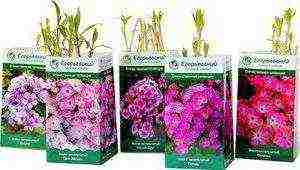 The plant is divided into bush and ground cover species.
The plant is divided into bush and ground cover species.
Low-growing perennial
Creeping or ground cover bushes can have stems from 5 to 40 cm long. They grow well in width, therefore they are often used to decorate an alpine slide. The most popular undersized phlox varieties are:
- Forked... A plant with slightly pubescent stems and an unusual shape of flowers. The petals of the buds are dissected, which makes it seem that this is not one, but several flowers. The color of the inflorescences is mainly blue and white.
- Douglas... A bush up to 10 cm high is distinguished by a dense cushion of flowers that are located on rigid stems. The color can be purple, white, lilac. Flowering lasts from May to June.
- Phlox subulate... A popular low-growing plant with stems up to 18 cm long. When planted in open ground, the subulate phlox covers a large area of soil with purple, white or pink inflorescences. The first flowering of the plant is in May-June, after which, in August and September, beautiful numerous flowers bloom again on the bush.
Gallery: phlox (25 photos)
Bush perennial
 Plant bushes are the most common and most commonly decorate flower beds in the garden... They are short - up to one meter in height and tall - more than a meter in height.
Plant bushes are the most common and most commonly decorate flower beds in the garden... They are short - up to one meter in height and tall - more than a meter in height.
Same
Low-growing varieties:
- Orange Perfection - a variety with salmon-colored buds that appear pink in the bright sun.
- Tiara - an unpretentious and beautiful plant with emerald greenery, against which the inflorescences stand out with their snow-whiteness.
- Sherbet Cocktail Is a fast-growing shrub with olive-colored flowers.
Tall varieties:
- Magic Blue - a variety that blooms with scarlet, blue, lilac or white flowers that bloom in early summer and adorn the garden until September.
- Tenor Is an abundantly flowering plant with bright purple-red inflorescences.
- Nicky - perennial bush up to 1.2 meters high. At the beginning of summer, dark saturated flowers bloom on it, which fade only in September.
- Natasha - a plant up to one and a half meters high with blue and white buds.
- Windsor - one and a half meter bush, it is distinguished by elongated oval-shaped leaves and the color of inflorescences from white to carmine.
Reproduction
 There are several ways to reproduce and grow perennial phlox:
There are several ways to reproduce and grow perennial phlox:
- seed;
- cuttings;
- dividing the bush;
- layering.
From seed
 A plant grown from seeds will be the most adapted to the climate of the region. Seeds are sold in the store, but if phlox are already growing on the site, planting material can be collected on your own. To do this, in the fall, when the leaves of the plant wither, they pluck the brown seed box and extract the seeds from it. They should be dark green and dense in structure.
A plant grown from seeds will be the most adapted to the climate of the region. Seeds are sold in the store, but if phlox are already growing on the site, planting material can be collected on your own. To do this, in the fall, when the leaves of the plant wither, they pluck the brown seed box and extract the seeds from it. They should be dark green and dense in structure.
Seeds are planted phlox in the fall. This is due to the fact that the planting material extracted from the seed pod quickly loses its germination and should be used as soon as possible.
For phlox, it is recommended to choose a windproof well lit place... In the lowlands, under the crowns of trees and in the shade, perennial flowering plants will feel uncomfortable.
It is recommended to plant phlox in November, having prepared a flower bed in advance for sowing seeds. Snow is cleared from it and seeds are laid out on the surface of the soil. Sprinkle them 1 cm layer of prepared or purchased potting soil and snow. With this method of planting, seed germination is about 70%.
You can sow seeds not in the ground, but in filled with soil mixture, humus and sand containers. Sowing is carried out to a depth of 1–2 cm. The container is left outside, sprinkled on top with foliage or snow. In the spring, it is brought into a warm room, where the seeds will begin to hatch and germinate.
Gallery: phlox in garden design (25 photos)
Cuttings
 Cuttings for planting can be cut from almost any part of the bush:
Cuttings for planting can be cut from almost any part of the bush:
- At the beginning of summer, leafy cuttings are harvested, which should be with an axillary bud and leaf. The bud deepens into the ground by 1–2 cm. Rooting should take place in a greenhouse at a temperature of +20 ° C to +30 ° C. Timely soil moistening is necessary. By autumn, leafy cuttings germinate, and in the spring they land in the open priming.
- Stem cuttings are cut in May-June or September. On a segment about 10 cm long, there should be at least two knots. The bottom cut is made just below the knot, and the top one is 2–3 cm above the knot. The lower leaves are removed from the cut, and the cuttings are placed in water for an hour. Sections should germinate in moist soil. Before planting, a small cut should be made at the bottom of the segment. The container with cuttings is covered with a film on top.
- Root cuttings are harvested in May-June... To do this, the bush is dug up, and healthy roots are cut into 5 cm long pieces. A container with sand and earth is prepared for them, where they are planted obliquely. Germination takes place for the first two weeks at an air temperature of 10 ° –15 ° С, after which the container with cuttings should be placed in a room with an air temperature of 20 ° –25 ° С. The soil must be moistened regularly. This method of growing phlox is used mainly when a shrub is infected with nematodes.
By dividing the bush
In the spring or early fall, you can dig up the bushes and divide them. For this, a healthy, mature four- or five-year-old plant is selected. Dig it out carefully so as not to injure the roots. When dividing into parts, the root collars are carefully separated. Delenki land on a new permanent place.
Layers
Layers are made from the lower shoots, which are bent and pinned to the ground, sprinkled with soil on top and moistened. After the layers take root, they are separated from the main bush and planted in a prepared place.
Landing features
Phlox can be planted almost at any time of the year:
- Bush planted in late April-early May
 will quickly take root, but bloom two weeks later than usual.
will quickly take root, but bloom two weeks later than usual. - In summer, phlox are planted already blooming. The inflorescence must be cut off, the plant should be shaded and watered well.
- In autumn, planting should be done in September. Before the cold weather, they must take root and stock up on nutrients for the winter.Phlox will bloom next summer.
The plant should be planted in a well-lit place with a deep location of groundwater. Although the culture loves moisture, excessive moisture in the soil can lead to the occurrence of various fungal diseases and rotting of the roots.
The soil should be fertile, loose, permeable and light. The best option is loam with neutral or slightly acidic acidity. Wood ash and compost are added to the planting hole. If the acidity of the soil is increased, then lime is added.
When planting plants, the distance between them should be:
- 60–70 cm for tall bushes;
- 50 cm for medium-sized bushes;
- 35–40 cm for ground cover phlox.
In pre-prepared holes, the seedling is placed vertically. The roots are straightened and covered with earth, which is compacted. Each planted bush must be watered well. It is recommended to mulch the soil around the plant with humus or peat.
In one place, under favorable conditions, the culture grows and blooms well for 10 years. But experienced florists advise replanting phlox every seven years. This is done to enhance flowering and rejuvenation of the shrub.
Care
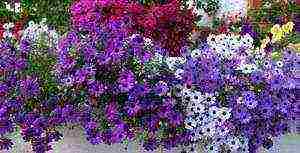 Growing a plant will not require a lot of effort and hassle. Phloxes are moisture-loving, therefore, first of all, it is necessary to monitor the soil moisture. Watering should be regular and abundant. But the culture also does not tolerate stagnant water in the ground.
Growing a plant will not require a lot of effort and hassle. Phloxes are moisture-loving, therefore, first of all, it is necessary to monitor the soil moisture. Watering should be regular and abundant. But the culture also does not tolerate stagnant water in the ground.
The shrub should be watered at the root so that water does not get on the inflorescences and leaves. On very hot days, watering should be done in the morning and evening.
Around the plant, it is necessary to regularly remove weeds and loosen the soil. Will inhibit the formation of weeds and retain moisture in the soil with mulch (peat or humus) that can be spread around the plant.
It is recommended to feed bush phlox three times per season:
- As soon as the first shoots and leaves begin to appear on the plant, it must be fed with organic fertilizers. It can be wood ash or manure infusion (for 8 liters of water - 30 g).
- During the swelling of the buds, a second feeding is done with special mixtures for flowering plants or mineral fertilizers.
- At the end of summer, after flowering, the bushes are fertilized with phosphate and potassium. This will help the plant to set buds for the coming season and give strength for root development.
Fertilizers are applied after watering the plant.
In the fall, after the bushes have faded, they need to be prepared for winter. This requires:
- Cut the shoots before the first frost to
 only 5–6 cm hemp remained.
only 5–6 cm hemp remained. - Cover the bushes with dry peat or fallen leaves. Leaves are harvested in spring, and peat can additionally serve as fertilizer.
- At subzero temperatures, when the ground is already frozen, pour one tablespoon of mineral fertilizer and a little ash under each bush.
In this form, phloxes will be able to winter well and will not freeze in snowless winters.
Pests and diseases
Under unfavorable growing conditions and improper care, plants can be affected by various diseases:
- Fungal diseases of the roots are indicated by the faintness of the color and wilting of the bush.
- Powdery mildew can be recognized by a whitish coating on leaves and shoots.
- With fomoza, the stem cracks, and the leaves turn yellow and curl.
- Leaf spot can be recognized by brown spots that grow more and more.
All diseases must be treated with special drugs that can be bought in gardening stores.
Of the pests on phlox, you can find caterpillars and butterflies, slobbering pennits, slugs, nematodes. You can get rid of them with folk remedies or insecticides.
Beautiful, long-blooming and showy phloxes can be propagated and grown independently. With proper planting and good care, bright inflorescences will decorate the garden all summer.
Attention, only TODAY!
 Due to their varied shades, abundant flowering and unpretentiousness, phloxes have received well-deserved love among gardeners. Plants growing naturally in North America are very popular in all European countries. Even a beginner in floriculture can cope with their cultivation and care, subject to all recommendations and rules.
Due to their varied shades, abundant flowering and unpretentiousness, phloxes have received well-deserved love among gardeners. Plants growing naturally in North America are very popular in all European countries. Even a beginner in floriculture can cope with their cultivation and care, subject to all recommendations and rules.
Description, types and varieties of phlox with a photo
Annual phlox has the greatest variety of shades, shapes and varieties. They can be star-shaped or terry, blue, white, cream or different shades of red.
One of the best annuals is the Drummond phlox, which is native to Texas. The plant is branched bush, the height of which can be from 12 to 30 cm. Its opposite leaves are oval-lanceolate. Fragrant flowers can be salmon, yellow, white, dark red or purple.
The most popular varieties of Drummond annual phlox are:
-
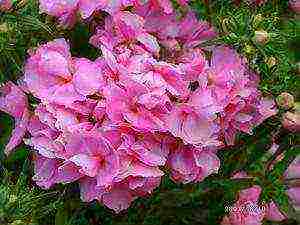 The Promis Pink variety is a low-growing plant up to 20 cm high. Its double flowers are pink in color. The variety looks good as separate bushes on alpine hills and in compositions in flower beds and flower beds.
The Promis Pink variety is a low-growing plant up to 20 cm high. Its double flowers are pink in color. The variety looks good as separate bushes on alpine hills and in compositions in flower beds and flower beds. - Variety "Constellation" is a lush bushes with flowers of bright colors with a diameter of up to 3 cm. Its inflorescences in the form of shields have a fragrant aroma and can be from white to red. The variety is used not only for decorating flower beds, but also for making bouquets.
- Annual undersized phloxes belong to a new variety. Branched bushes grow up to 20 cm and have pubescent leaves. The variety is widely used to decorate loggias and balconies.
- Terry phlox are bushes up to 30 cm in height. Their dense inflorescences consist of large double flowers. Shades of petals can be from cream to dark red. Grown for decoration of flower beds in the garden, balconies and loggias. Terry phlox are suitable for growing in pots and decorating rooms.
- Variety "Twinkling Star" is a miniature bushes up to 25 cm high. The petals of its flowers have an unusual shape with pointed tips. It blooms from June to September, both outdoors and at home.
- Variety "Star Rain" is a rather tall shrub with straight and side stems. Its height can be up to 50 cm. Fragrant flowers resemble stars and bloom for a long time. The variety is resistant to drought and frost, grows well in the sun, and practically does not bloom in the shade.
Annual phlox: growing from seeds
To achieve longer flowering, Drummond phlox it is recommended to grow seedlings... Seeds sown directly into the ground take a very long time to sprout, and the plants grown from them bloom only at the end of summer. Earlier flowering can be obtained by sowing seeds in open ground before winter.
Sowing seeds in open ground
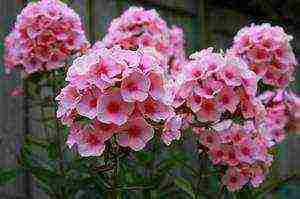 It is necessary to plant seeds immediately on a flower bed in October - November. If there is already snow, then it is removed, and the seeds with a distance of 4-5 cm are scattered directly onto the frozen ground. To protect the plants from freezing, the beds are first sprinkled with prepared earth, then with snow and cover with leaves or straw... Seedlings will hatch in early spring. When two real leaves appear, they will need to be cut open, seated at a distance of 20 cm from each other.
It is necessary to plant seeds immediately on a flower bed in October - November. If there is already snow, then it is removed, and the seeds with a distance of 4-5 cm are scattered directly onto the frozen ground. To protect the plants from freezing, the beds are first sprinkled with prepared earth, then with snow and cover with leaves or straw... Seedlings will hatch in early spring. When two real leaves appear, they will need to be cut open, seated at a distance of 20 cm from each other.
Sowing phlox seedlings
At home, sowing is done in early - late March. It all depends on when the last frost ends in your region. In order for the seeds to germinate quickly, it is not necessary to press them into the soil. From above, they are slightly sprinkled with an earthen mixture and sprayed with warm water.
Seedling boxes covered with glass or polyethylene, and put away in a warm place. The soil must be ventilated daily. When the first seedlings appear, the containers are installed in a well-lit place, and the glass or polyethylene is removed. At this stage, seedling care consists only in keeping the soil moist.
After the appearance of two or three true leaves, young plants are planted in separate pots. Behind them already special care will be needed:
- In the early days, the seedlings are covered from the sun's rays with an opaque film or newspaper.
- When the sprouts take root, and their sixth true leaf grows, they are pinched in order to form a lush and compact bush.
- Before planting in open ground, seedlings are fed twice with mineral fertilizers.
- In April, young plants need to be hardened. To do this, the pots are put on an open balcony or garden for an hour or two.
Annual phloxes are planted in open ground after the end of frost, at the end of May. By this time, some varieties have already formed buds.
Phlox Drummond: planting and growing in the open field
Grown, matured and hardened seedlings are planted in well-lit areas, sheltered from the scorching sun. Plants will grow best in partial shade on high flower beds... In the sun, phlox inflorescences fade, and in partial shade, color saturation remains for a long time.
Landing features
 Annual phloxes dislike acidified areas and poorly drained soils. The best earthen mixture for them is fertile sand without clay. Lime can be added if necessary. If there are heavy loams on the site, then they are diluted with peat, organic fertilizers and sand.
Annual phloxes dislike acidified areas and poorly drained soils. The best earthen mixture for them is fertile sand without clay. Lime can be added if necessary. If there are heavy loams on the site, then they are diluted with peat, organic fertilizers and sand.
Seedlings are planted in shallow pits, at the bottom of which compost or vermicompost is poured and some ash. The roots are gently spread horizontally and covered with earth. The plants are watered, the soil around them is mulched.
Watering and feeding
Caring for Drummond phloxes, after planting them in open ground, will not be difficult. For the entire season, it is required to loosen the soil twice a month and to huddle it in the second half of the growing season. In this case, the root system will form faster.
Phlox is watered moderately, but regularly. One square meter of planting consumes one and a half to two buckets of water. On hot days, watering is done in the morning and evening. The water is poured directly under the root. It should not be cold, otherwise the roots may crack in the heat.
Drummond Phlox is fed several times per season organic and mineral fertilizers:
-
 At the end of May, the bushes are fed with liquid manure, at the rate of 25-30 grams per bucket of water.
At the end of May, the bushes are fed with liquid manure, at the rate of 25-30 grams per bucket of water. - In early June, superphosphate and potassium salt are added to the liquid manure.
- In early July, only liquid manure is again used to fertilize phlox.
- At the end of July, plants are fertilized with potassium salt and phosphorus.
During the season, the tops of young plants are pinched. In this case, the bushes begin to branch better. Faded and wilted flowers are regularly removedto preserve the attractive appearance of the flower and prolong its flowering.
A flower bed of Drummond phlox of different shades and varieties looks beautiful and impressive. They can be used to decorate alpine slides and curbs. A large blooming ball decorating the courtyard can be obtained by planting annual phloxes in pots or buckets, and placing them side by side. With proper care and cultivation, it will be possible to admire its flowering throughout the warm season.
Phlox Drummond
Rate the article:
(8 votes, average: 5 out of 5)
